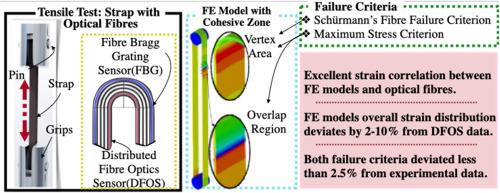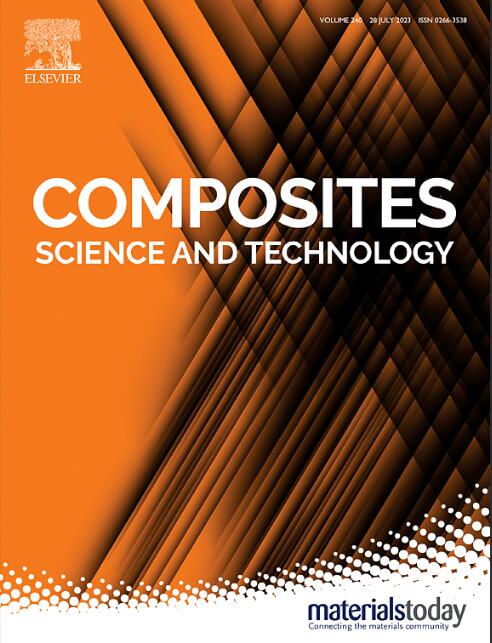Experimental and numerical investigations on the tensile response of pin-loaded carbon fibre reinforced polymer straps
IF 8.3
1区 材料科学
Q1 MATERIALS SCIENCE, COMPOSITES
引用次数: 0
Abstract
Carbon fibre reinforced polymer (CFRP) pin-loaded looped straps are increasingly being used in a range of structural load-bearing applications, notably for bridge hanger cables in network arch rail and highway bridges. The static performance of such CFRP straps is investigated through experimental and numerical analyses. Finite element (FE) models based on both one-eighth and half pin-strap assembly geometries were modelled. The resulting strains, stresses, and applied loads were compared against experimental data obtained using Digital Image Correlation, Distributed Fibre Optic Sensing (DFOS), and Fibre Bragg Grating (FBG) Sensing. The FE models effectively captured local strain distributions around the vertex area, close to the pin ends of the straps, as well as in the mid-shaft region, and aligned reasonably with experimental observations. The half FE model accurately predicted the overall strain distribution when compared to DFOS data; however, higher strain magnitudes (by 0.45–10.2 %) and larger strain reductions were observed in some locations. Regarding failure loads, the FE models agreed well with Schürmann's analytical solution and the maximum stress criterion, exhibiting less than 2.5 % deviations from the experimental data. Furthermore, the predicted onset of strap failure (by delamination) in the half model agreed with experimental values, with a maximum variance of 9.2 %.

针加载碳纤维增强聚合物带拉伸响应的实验和数值研究
碳纤维增强聚合物(CFRP)销轴加载环形带越来越多地应用于各种结构承重领域,特别是网拱铁路和公路桥梁中的桥梁吊索。我们通过实验和数值分析研究了这种 CFRP 带的静态性能。有限元(FE)模型基于八分之一和半销带装配几何形状。得出的应变、应力和外加载荷与使用数字图像相关性、分布式光纤传感(DFOS)和光纤布拉格光栅(FBG)传感获得的实验数据进行了比较。有限元模型有效地捕捉到了顶点区域周围、靠近带销两端以及中轴区域的局部应变分布,并与实验观测结果进行了合理的比对。与 DFOS 数据相比,半有限元模型准确预测了整体应变分布;然而,在某些位置观察到了更高的应变幅度(0.45-10.2 %)和更大的应变减小。在破坏载荷方面,有限元模型与 Schürmann 的分析解决方案和最大应力准则非常吻合,与实验数据的偏差小于 2.5%。此外,半模型中预测的表带失效起始点(分层)与实验值一致,最大偏差为 9.2%。
本文章由计算机程序翻译,如有差异,请以英文原文为准。
求助全文
约1分钟内获得全文
求助全文
来源期刊

Composites Science and Technology
工程技术-材料科学:复合
CiteScore
16.20
自引率
9.90%
发文量
611
审稿时长
33 days
期刊介绍:
Composites Science and Technology publishes refereed original articles on the fundamental and applied science of engineering composites. The focus of this journal is on polymeric matrix composites with reinforcements/fillers ranging from nano- to macro-scale. CSTE encourages manuscripts reporting unique, innovative contributions to the physics, chemistry, materials science and applied mechanics aspects of advanced composites.
Besides traditional fiber reinforced composites, novel composites with significant potential for engineering applications are encouraged.
 求助内容:
求助内容: 应助结果提醒方式:
应助结果提醒方式:


